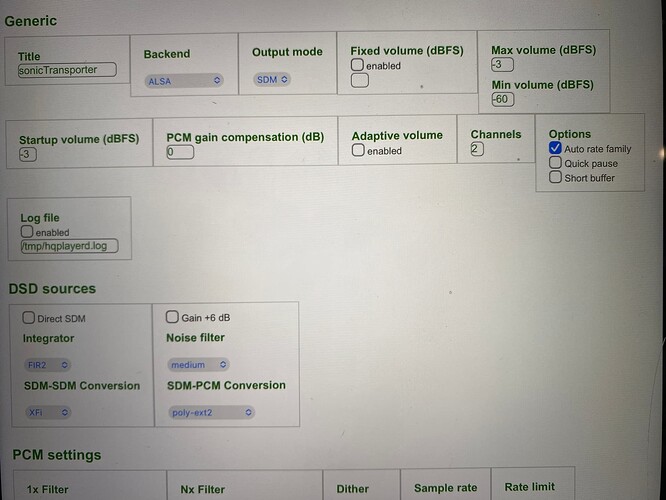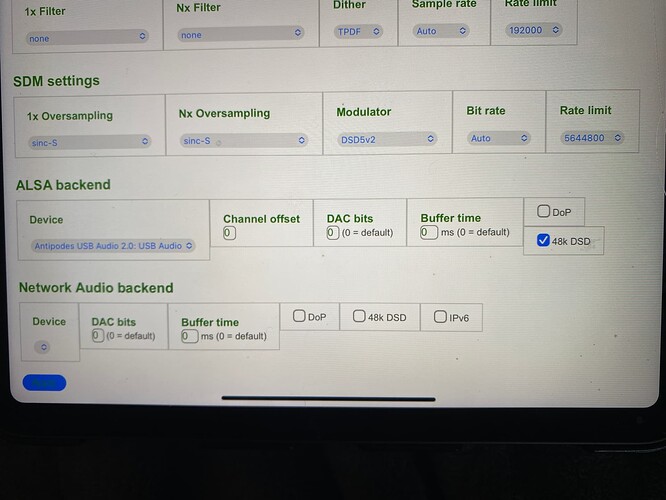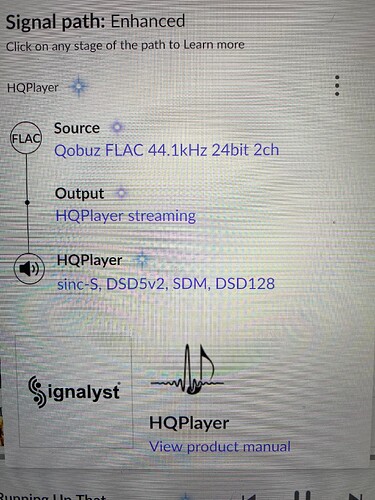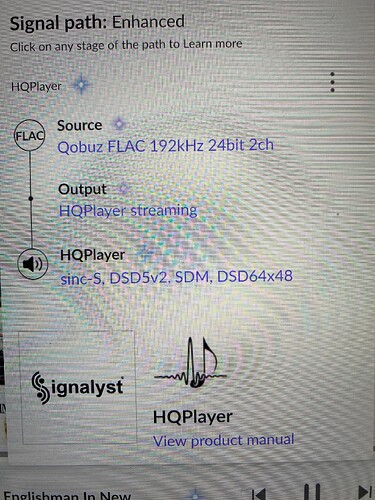Thanks for this Nick. After selecting the poly-sinc-long-mp filter, with LNS15 dither and sample rate set to auto, the output rate is now 768K with no problems. And it sounds pretty good as well (I still prefer SDM output using poly-sinc-long-mp-2s, with DSD 256+fs though). So there is clearly a relationship between those three things that I do not yet understand. And I can’t find any technical documentation on HQPlayer online…
I obtain this by downloading HQPlayer desktop for Mac. The user guide is included and it has details about the settings.
Sinc -L, Sinc-M , Sinc-Mx all have a 5 second delay. it’s the way of the filters…so don’t worry about your set up, it’s normal.
Bill
Hello guys,
How are you doing?
I hope everything is well!
Could please inform me how to use Hqplayer on my Antipodes K50
I am using Chord Dave and to be honest i like such combo, i haven’t Chord m scaler and prefer to use Roon + Squeeze and want to try Roon + Hqplayer
On player part i just select HQplayer
Setup
There is no need to perform any setup of HQPlayer NAA. Just select it as the Active player at the Players screen. All setup is performed within the HQPlayer Server Embedded app.
Use NAA when you wish to use K50player as the Player and will be using HQPlayer Server on a separate device - whether it is an Antipodes music server or any other device running HQPlayer Server.
I have did that, also i have added endpoint to Roon with ip of player, but when i try to playback i got error “playback failed because roon couldn’t connect to hqplayer”
Setup
You can use HQPlayer in two different ways:
- Setup HQPlayer on a single Antipodes Music Server (with the library setup on the same Music Server).
- Setup Roon Server on one Antipodes Music Server (with the library setup on this Music Server) and HQPlayer setup on a second Antipodes Music Server.
Remote Control
With method 1 above, you can use the HQPlayer remote control application. Or you can use Roon Server on the same Music Server to act as the Server App and use HQPlayer as the Player App - in which case you use the Roon remote control app to control Roon Server. The Roon Server app allows you to set HQPlayer as a Player.
With method 2 above, simply open Roon Server and set HQPlayer as the Player App. (What does it mean) ?
Note that if you want to use computation-intensive DSP features in HQPlayer then you will need to install HQPlayer on a powerful server model.
Could you please tell me how to make the correct setup ? Thanks!
I use Roon in combination with HQplayer on my K50.
I want to upsample all files to dsd in HQplayer (I2S output).
But i can max upsample to DSD 64 (2822400 Bitrate).
Higher bitrate DSD 128 or DSD 256 is possible!?
What causes these limits?
I have been able to go as high as DSD256. My DAC supports DSD512, but dropouts occur. I haven’t tried to figure out why as I’m awaiting the return of the CPU meter.
The first thing to check is your DAC. What is the max rate that is supported? And does it support native DSD of DoP.
From there check the specs of your server. The K50 supports up to DSD256 for DoP and DSD512 for native DSD.
As in my case, just because my DAC and server can both support DSD512, it doesn’t mean it will play back smoothly. The filter selected in HQPlayer will determine CPU utilization. One must be careful to select a filter that doesn’t place too much of a load on your server.
I get DSD256 with the following settings. I prefer PCM upscaling so this is about as far as I can go with advice on DSD filters and settings.
Reviving a slightly old thread, as I’m going down the Roon + HQP rabbithole.
I’m using a K22 connected to my DAC by i2s. K22 specs are DoP to DSD256 and Native DSD to DSD512. My DAC’s i2s specs are DSD64~DSD1024 and DOP 64~256. The DAC is a Musetec 005, which has dual 9038 chips. I’m unsure atm whether the Musetec supports 48K DSD: more on that below.
I don’t have any DSD files, so I’m converting PCM to DSD in HQP Embedded. I use Qobuz, so play music which ranges from basic CD 44.1 standard through to 192 hi res. Hence the HQP settings I’m hoping to achieve will work with this range of PCM source material. Ideally I don’t want to have to keep delving back into the HQP settings to apply different settings for 44.1, 96, 192, etc.
The K22 i2s configuration is the PS Audio standard. The DA005 pin config is in the manual, but I don’t know if it’s the same. I have been able to play whole tracks without drop outs, so clearly something is working OK, but with the observations below.
DSD 256 doesn’t seem generally feasible, unless I use the most ‘basic’ DSD5 modulator. Only DSD 128 seems stable, but the ‘highest’ 5 type modulator I can use is DSD5V2. I understand that you need to use the 5 family modulators with ESS DACs (per Jussi).
I have ticked the 48K DSD box: I don’t know whether the 005 actually supports that, but I seem to get drop outs otherwise.
Regarding filters, the poly sinc family appear stable, and sinc S, but that’s all.
I have ticked the Auto Rate Family box, as it doesn’t appear to work otherwise.
My settings are below. I have also taken screenshots for 44.1 PCM and 192 PCM using this approach. 44.1 scales to DSD 128, and 192 scales to DSD 64x48.
Does anyone have any thoughts on all this? Is the K22 processor likely to be limiting what I can achieve?
From the K22 product page here:
“Because the K22 does not support DSP functions, it cannot use HQPlayer Server App, but it does support HQPlayer NAA.”
The reality though is that it can run HQPlayer server, but only with filters that aren’t too CPU-intensive. You could probably get away with PCM upscaling. Just make sure the K22 doesn’t run too hot.
Many thanks for this, I hadn’t spotted that on the K22 webpage. So the K22 seems to be the bottleneck rather than me having selected the wrong settings in HQP, or some other reason.
This is a bit vexing, but not much I can do about it. The question I’ll have to figure out is whether the most I can achieve with PCM → DSD in HQP (currently sinc S / DSD5v2 / DSD128) is worth it in terms of sound quality. That’s either vs ‘pure’ PCM with HQP taken completely out of my chain, or PCM amended in HQP with Jussi’s favourite filters 1x=poly-sinc-gauss-long / Nx=poly-sinc-gauss-hires-lp / TPDF dither.
In addition I could uprate the PCM to 384kHz, as the K22 i2s output supports that.
Or the expensive option: buy an M Scaler (if its compatible with the Musetec, would need to check).
Another option is to buy a high spec Windows laptop, and run the K22 as an NAA with it. This is worth thinking about, but I don’t have a technical background, and this sort of thing gives me a slight headache.
How would I integrate a Windows laptop into my system? How would it interface with the K22, etc etc. Presumably Roon / HQP / Qobuz would run on the laptop, so that bit I get (I think).
My Gustard x26pro has the same ESS DAC chips as your DAC. When streaming, I use HQPlayer to scale to 16FS (705.6/768k) as I find that it brings a portion of the benefits I heard from an M-Scaler for a lot less money. You would get slightly less of a benefit scaling only to 8FS PCM, but it’s worth trying.
I have not had a device that could do the DSD scaling that Jussi favors as it needs a powerful CPU. I did get to hear a file that was scaled using HQ Player Pro and concluded that approach is not for me.
Tough spot to be in not knowing how well one’s DAC might respond without having a PC handy that’s powerful enough to give you a full taste of what HQPlayer can do.
Ah interesting. When using HQP to scale like that, do you apply any filters to the PCM in HQP as well (e.g. Jussis’ favourites above)? Or you just push up the rate without filters? I’m assuming you have to apply one of the dithers as well (I don’t think No Dither is an option).
I’ve just checked the specs and I’m actually limited to 384 anyway. The K22 i2s PCM output is limited to 384, and only the USB output supports 768. Conversely (or perversely) the USB input on the DAC is limited to 384 (but the i2s supports 768).
I just rely on my ears. And my ears have told me that that HQPlayer’s DSD scaling is not for me.
Since I only use HQPlayer when streaming with Roon/Qobuz, the source material is PCM. So HQPlayer is scaling to PCM with the sinc-Mx filter and the TDPF dither.
I use an offline scaling application, PGGB, to scale my favorite albums to 16FS. These sound significantly better to my ears than what can be achieved from either HQPlayer of Mscaler, but this comes at a higher cost, both in terms of dollars and in time. It’s also not a real time solution so it can’t scale on the fly like the other two.
I’ve had a look at the latest AMS software thread. I realise that this is on hold at the moment, but one thing in the release notes caught my eye: HQPlayer moves to version 5.4.0, and with this comes major changes in CPU support determined by Signalyst, HQPlayer Embedded is no longer supported on non-AVX machines, (eg. EX, K22).
I only have a K22 in my system, which I use both to stream music from Roon / Qobuz, and also play music from my ripped CDs (on the SATA drive). The K22 is connected to my router via ethernet cable, and it’s also connected to a DAC. It seems that using HQP isn’t going to be an option using my K22 with the new AMS software, so I’m wondering what to do.
I think the best option would be to run a separate high spec Windows laptop with Roon + HQ Player Desktop on it (I bought a licence for HQP Desktop 4 a couple of years ago, hopefully it’s still valid). The K22 would remain connected to the LAN via Ethernet cable. The Windows laptop would be connected to my LAN via WiFi, and I think I’d be able to continue to control my music using the Roon app on my iPad.
Is this correct? If so then what settings would I set for Solution / Server / Player in the Antipodes K22 control page?
Many thanks.
The K21 was intended to be a player/endpoint so it uses a lower-power CPU to reduce noise. Loading it up with heavier processing somewhat defeats its purpose.
Doing the heavy lifting on a separate box is definitely the way to go. This is actually simplified if Roon is involved. Roon can be configured to stream to HQPlayer Desktop and then HQPlayer desktop can then be configured to stream to your K21 running HQPlayer NAA (HQPlayer NAA).
Though I said this simplifies things, the configuration still isn’t the easiest thing to do. I did it years ago when I was using a microRendu as an NAA. A lot of folks use HQPlayer desktop in this fashion so there are some good articles/posts online explaining how to configure things.
Thanks for the info. In terms of connections then is this correct: new Windows laptop with Roon and HQP Desktop is connected to my router using Ethernet cable? And the laptop is connected to the K22 presumably by a USB cable?
I have to admit I’m wondering whether in fact to sell the K22, and revert to my previous approach. This involved having a dedicated Windows music laptop with Roon / Qobuz / HQP Desktop on it, and this was connected to my DAC. To be honest this worked very well.
I realise that the K22 is partly aimed at reducing noise, and has other advantages , but having to introduce a new laptop in my chain to be able to run HQP is one more box in my system that I could possibly do without.
It all depends on how important sound quality is relative to the number of boxes. The K22 is a world class player/endpoint. A separate box to run server apps is the best way to go - and the developers of both HQPlayer and Roon will agree with this.
i would love to try HQP with roon but the delay on playback, skip to next track etc etc is unbearable. If theres any way to use HQP without the delay i would be interested to know how. As far as i can tell it doesnt matter what filters you use - HQP always has a delay through roon





